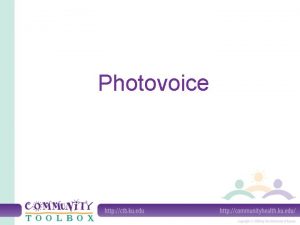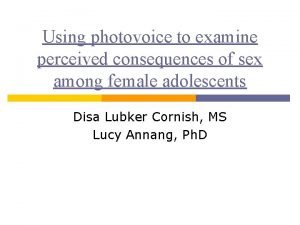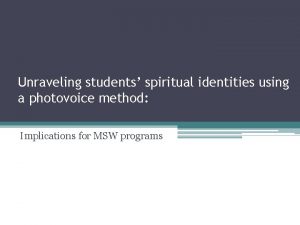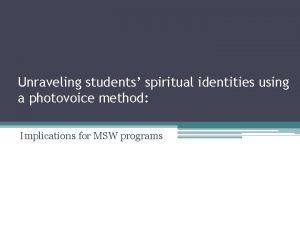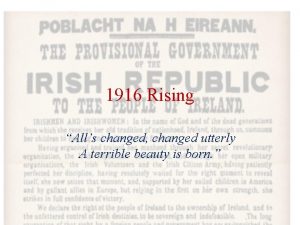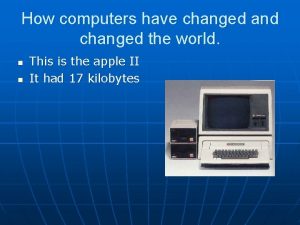2017 Food for Changed Thought Series Photovoice Using











































- Slides: 43

2017 Food for Changed Thought Series Photovoice: Using Photos and Stories to Create Community Change The University of Texas at El Paso January 25, 2017 © The University of Texas at El Paso

Thank you for being here today! Introductions Lucia Dura, Ph. D. UTEP, Department of English, Rhetoric and Writing Studies Antonio Martinez UTEP Latino Alcohol and Health Disparities Research Center Eva Moya, Ph. D. , LMSW UTEP College of Health Sciences, Department of Social Work Lauren Perez, M. A. UTEP Positive Deviance (PD) Ambassador Vanessa Sandoval UTEP M. A. Student in Communication Maria Torres, Ph. D. UTEP Alumna Interdisciplinary Health Sciences © The University of Texas at El Paso

Objective: By the end of the session, you will be able to: ü Describe the goals of Photovoice ü Explain the methodology ü Explore the use of Voices and Images to create community change In summary, Voices and Images is about: SHARING PICTURES, TELLING STORIES, EMPOWERING PEOPLE, AND CHANGING COMMUNITIES © The University of Texas at El Paso

Think and Share Ø Give a name or title to the photograph Ø Describe what you See Ø Describe what might be Happening Ø How does the photograph relate to Our life Ø Why might that situation exist Ø What can we Do about it. 4 © The University of Texas at El Paso 11/28/2020

PHOTOVOICE GLOSSARY OF TERMS © The University of Texas at El Paso

Photovoice Defined Ø Photovoice is a Participatory Action Research method that employs photography and group dialogue as a means for marginalized individuals to deepen their understanding of a community issue or concern. Ø Involves community members taking pictures of their own realities followed by small group consciousness-raising discussions and presentations to decision makers. Ø Initially developed by Drs. Caroline Wang & Mary A. Burris in 1994 in China. © The University of Texas at El Paso

Photovoice Foundations Ø Images trigger community self-reflection and discussion to examine root causes of community conditions. Ø Participatory approach recognizes and honors community members’ subjective experience as researchers, advocates, and participants. Ø Photographs and stories have been used for decades as a mechanism for social reform. © The University of Texas at El Paso

Photovoice: Underpinnings Education for critical consciousness Participants consider and seek to act upon the historical, institutional, social, and political conditions that contribute to personal and community problems (Freire, 1974; Minkler & Wallerstein, 2014) Feminist theory Everyone has a specific story, a particular experience of the configuration of class, race, gender, sexuality, family, country, displacement, alliance…. Those stories are mediated by the forms of representation available in the culture (Wang, 1999; 2004) Documentary photography © The University of Texas at El Paso

Examples of Photovoice Projects Language of Light Project. Homeless women and men living in a shelter in Ann Arbor, MI (Wang, Cash, & Powers, 2000). The Voices of Students at Risk: A social validity study of Photovoice with at-risk students in Midwestern city (Kroeger, 2003). Giving local health departments a new perspective on community health issues, Contra Costa, CA (Spears, 1996; Pies & Parthasarathy, 2005). © The University of Texas at El Paso

Photovoice is designed to enable people to: • Produce and discuss photographs as a means of catalyzing personal and community change. • Document persons reality of their lives. • Use the power of visual images to communicate their experiences and perceptions. • Through critical reflection, discuss individual change, community quality of life and policy issues (Wallerstein, 1987). • Creates evidence and promotes vivid participatory means of sharing experiences and knowledge through the immediacy of the visual image. © The University of Texas at El Paso

Participatory Action Research (PAR) A method of collaborative research that involves increased understanding of an issue of concern and efforts aimed at improving social conditions through individual and group action. Photovoice is a form of PAR © The University of Texas at El Paso

Method Photovoice Practice & Action Research Data collection Data analysis Report writing Galleries CBR project design Resource development Assessment tool Need identification Asset mapping Empowerment Political commitment Making changes Participatory Action Research (PAR) © The University of Texas at El Paso

Photovoice Facilitator An individual that has a range of skills necessary to facilitate the form of PAR. Requires knowledge of the research process, ethical guidelines and method. Assumes the role of co-researcher and works closely with community members. © The University of Texas at El Paso

Photovoice Participant A community member representing a marginalized group who agrees to take part. Fulfills several roles in order to achieve the goals of the project. Persons affected by social condition who take photos and describe through stories in small group meetings! © The University of Texas at El Paso

Roles of Participants • • Link with the community Gain trust with co-researchers Take, selection and sort photographs Explain stories in the meetings Participate in data collection Helps reduce barriers Participate in community meetings, photo exhibition • Advocates for change with policy and decision makers © The University of Texas at El Paso

Advisory Committee Members of a group who are selected to hear the message about the issue of concern conveyed through Photovoice. Members are selected based on their ability or power to influence decisions and policies and to make changes that can improve the lives of community members. Probably these are educators, activists, scholars social workers, health workers, researchers, members of the media, local leaders! © The University of Texas at El Paso

Marginalized Groups of individuals who are most excluded from public discussion and who have limited access to centers of influence and power. Able to have their voices heard and bring forth ideas to influence the decisions and policies that affect their lives. People with disability, health conditions, vulnerable groups, not getting access (limited or inadequate) to services! © The University of Texas at El Paso

Decision Makers Members of the community who have the ability or power to influence and make decisions on behalf of others. Includes policy -makers, those who determine public guidelines and policy. The audience in Photovoice includes decision and policy makers! © The University of Texas at El Paso

Co-Researcher A member of a group who shares responsibility for planning and carrying out a research project. In Photovoice, community members are coresearchers along with facilitator. Together, they make decisions about the focus of the project, collect and analyze data, create new knowledge and share findings with others. Community members along with facilitator! © The University of Texas at El Paso

Data Information gained through the research process. Photographs, taken by community members, and their stories describing and explaining the photographs, are the main data collected. Photographs with explanations! © The University of Texas at El Paso

Data Collection The process of gathering information through a variety of activities and events. Taking photographs, participating in group meetings, recording discussions, guided dialogue, exhibition feedback and debriefing. Data collection is ongoing because information is gained right from the beginning until the end. Capturing the photos and recording dialogues! © The University of Texas at El Paso

Coding Identifying and sorting data into categories of meaningful issues, themes or theories. Takes place through group discussions where participants share photographs and discuss common themes and issues. Participants show photographs and tell themes and issues! © The University of Texas at El Paso

Contextualizing Understanding or explaining how something fits within a larger set of circumstances. As participants engage in dialogue with other participants they can voice their individual and group experiences. For example, a photo of a sub-standard apartment can lead to a discussion of a larger context which includes the lack of affordable housing, low wages, social service shelter allowance policies and power relationships between tenants and landlords. Problem identification and or meaningful issues and themes! © The University of Texas at El Paso

Data Analysis The process of carefully exploring, examining and comparing the data collected. Through data analysis we develop a better understanding of the issue of concern being addressed. By analyzing the data, co-researchers can determine general themes and patterns, and identify how individual issues relate to the experiences of others. How individual issues relate to others! © The University of Texas at El Paso

Ethical Guidelines All research is governed by strict ethical considerations and guidelines. Researchers are expected to do no harm through research activities. The ethical principles ensure that participants and other individuals or groups are not harmed as a result of activities. © The University of Texas at El Paso

Informed Consent Agreement to do something or allow something based on having all the facts and being educated on risks and benefits. Participants must be educated about the complete process, the multiple roles and responsibilities and the advantages and the possible risks of participation. Only then, once fully aware can community members agree to participate. © The University of Texas at El Paso

Key Concepts 1. Images teach 2. Pictures can Influence policy 3. Community members ought to participate in shaping public policy 4. Influential policy-makers must be the audience to the perspectives of community members 5. Photovoice emphasizes individual and community action © The University Texas at El. Chavez-Baray, Paso (Wang, 1999; Wang & Pies, 2004; of. Moya, & Martinez, 2014).

STEPS IN THE PHOTOVOICE METHOD © The University of Texas at El Paso

Framing the First Questions Ø Who are the people that make up our community? Ø What are the natural and human-made features of our community? Ø What social systems make up our community? © The University of Texas at El Paso

Describing the Story What do you See here? Pretend someone can’t see the picture What is really Happening? Actions and feelings in the picture How does this relate to Our lives? Your feelings and how your experiences are similar or different Why does this situation, concern, or strength Exist? Underlying meaning and impacts on you and community What can we Do about it? Actions to be taken to solve problems or build upon strengths Develop by Nina Wallerstein and Edward Bernstein and adapted for use in Photovoice by Caroline Wang and Mary Ann Burris. Translated to Spanish by Eva Moya (2008) © The University of Texas at El Paso

Sharing Photos and Stories © The University of Texas at El Paso Photos courtesy of E. Moya

Presentación Comunitaria Imágenes por Voces e Imágenes de la TB 28/11/2020 Eva Moya y Silvia Chavez-Baray

Photovoice Methodology Training (Guachochi, CHIH) Photographs courtesy of O. Vasquez


Call to Action to Eliminate TB -Created by Photovoice Participants in South Africa

To download a copy of the Voices and Images articles, please visit www. casesjournal. org/volume 2

International Presentations 28/11/2020 Imágenes por Fotovoz TB Amaya-Lacson Eva Moya y Silvia Chavez-Baray

Train the. Trainer 28/11/2020

28/11/2020 Eva Moya y Silvia Chavez-Baray

28/11/2020 Eva Moya y Silvia Chavez-Baray

If you are thinking about Photovoice, here are some things to ponder: • Are you genuinely interested in community-based collaborative research? • Have you done background reading or learned enough about method to feel comfortable with use? • Have you secured funding for project? • Are you prepared to seek funding by writing proposals or connecting with agencies? • Do you have, or are you willing to develop, strong connections with the community? • Is there an issue in your community that you are deeply concerned about? • Do you have ideas about possible solutions or policy improvements related to that concerning issue? © The University of Texas at El Paso

Speed Networking: Take home message How could you use Photovoice method for community change? With students? For policy? Other…. © The University of Texas at El Paso .

Thank you http: //www. homelessopportunitycenter. org/ Welcome your questions, comments, suggestions emmoya@utep. edu © The University of Texas at El Paso
 Dr caroline wang
Dr caroline wang What is photovoice
What is photovoice How to make a photovoice
How to make a photovoice Complete or incomplete thought?
Complete or incomplete thought? Unit 2 food food food
Unit 2 food food food Food chain sequence
Food chain sequence Food for thought for teachers
Food for thought for teachers Food for thought for teachers
Food for thought for teachers Mc food for thought
Mc food for thought Food for thought
Food for thought Food for thought reading
Food for thought reading Maclaurin series vs taylor series
Maclaurin series vs taylor series Balmer series lyman series
Balmer series lyman series Serie de taylor
Serie de taylor Taylor series lesson
Taylor series lesson Ibm p series servers
Ibm p series servers General feedback structure
General feedback structure Series aiding and series opposing
Series aiding and series opposing Arithmetic series formula
Arithmetic series formula Formuö
Formuö Typiska novell drag
Typiska novell drag Tack för att ni lyssnade bild
Tack för att ni lyssnade bild Ekologiskt fotavtryck
Ekologiskt fotavtryck Shingelfrisyren
Shingelfrisyren En lathund för arbete med kontinuitetshantering
En lathund för arbete med kontinuitetshantering Personalliggare bygg undantag
Personalliggare bygg undantag Tidbok
Tidbok A gastrica
A gastrica Densitet vatten
Densitet vatten Datorkunskap för nybörjare
Datorkunskap för nybörjare Stig kerman
Stig kerman Att skriva en debattartikel
Att skriva en debattartikel Delegerande ledarskap
Delegerande ledarskap Nyckelkompetenser för livslångt lärande
Nyckelkompetenser för livslångt lärande Påbyggnader för flakfordon
Påbyggnader för flakfordon Formel för lufttryck
Formel för lufttryck Publik sektor
Publik sektor Bo bergman jag fryser om dina händer
Bo bergman jag fryser om dina händer Presentera för publik crossboss
Presentera för publik crossboss Teckenspråk minoritetsspråk argument
Teckenspråk minoritetsspråk argument Plats för toran ark
Plats för toran ark Klassificeringsstruktur för kommunala verksamheter
Klassificeringsstruktur för kommunala verksamheter Mjälthilus
Mjälthilus Bästa kameran för astrofoto
Bästa kameran för astrofoto












































